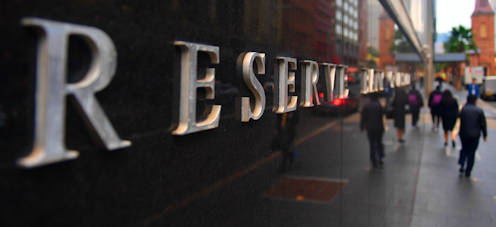The RBA's pre-COVID failure to cut interest rates faster may have cost as much as 270,000 jobs
- Written by Isaac Gross, Lecturer in Economics, Monash University

The Reserve Bank of Australia is about to be put under the microscope in the first major review of its performance in at least 30 years, and perhaps forever[1].
In research published this month in the Economic Record[2], Australian Labor member of parliament Andrew Leigh and myself analyse how the bank has set interest rates over the past two decades and grade its performance.
To do this we use the RBA‘s own model (called MARTIN[3]) to evaluate how well it has achieved its two key goals[4] of full employment and price stability.
We examine the bank’s performance across three periods:
The global downturn that began in 2001
The global financial crisis that began in 2008
The four pre-pandemic years from 2016 to 2019, in which inflation was below the bank’s 2-3% target band.
Top marks for the first two crises
We find that in each of the first two crises the bank did a good job. In the face of large economic shocks it cut interest rates to save jobs.
Low interest rates make it easier for businesses and households to borrow and spend. From 2001 the rate cuts lowered unemployment from 7% to less than 6%.
During the global financial crisis the bank again aggressively cut interest rates.
The bank’s model suggests that had it not decreased rates unemployment would have climbed to almost 8%. Instead, it fell to 5%, never even climbing as high as 6%.
The mark we assign to the bank for each of these two periods is a solid “A”.
A pre-COVID failure that cost people work
But we find that between 2016 and 2019 the bank dramatically under-performed.
During this period the economy entered a slump. Economic growth sank, wage growth was anaemic and inflation hovered below the bank’s target band.
The bank did cut its cash rate, but not by much, from 1.75% to 0.75%.
This relative inaction meant unemployment was kept higher than was necessary.
Relative to the optimal path identified by the RBA‘s model, we find this cost the equivalent of 270,000 people being out of work for one year.
The high cost of high interest rates
270,000 jobs is a big deal. By way of comparison, Melbourne’s suburban rail loop is estimated to create only 8,000 jobs[5] when construction starts on the first stage, while the national inland rail project is estimated to create around 20,000 jobs[6]. Closing Australia’s border is estimated to have cost 72,000 jobs[7].
Each of these is a massive public project or decision, but they are dwarfed by the bank’s decision to run the economy to slow over that four year period.
The stance taken by the bank under Governor Philip Lowe during those four years amounts to a substantial error. Such an error warrants a grade of “C-” at best.
Too much concern about home prices?
One explanation for this error might be that the bank didn’t want to boost house prices.
Governor Lowe told a business audience in 2017 that while he would like the economy to grow a bit more,
if we were to try to achieve that through monetary policy that would encourage people to borrow more and it would probably put upward pressure on housing prices. At the moment I don’t think those two things are in the national interest.
More recently he has backed away from the idea, telling the National Press Club in 2022 he did not think the idea of making the bank responsible for home prices made sense[8].
Using interest rates to restrain house prices is known as “leaning against the wind”. The Reserve Bank’s own researchers have found the costs of leaning against the wind are three to eight times larger[9] than the benefit of avoiding financial crises.
Read more: The RBA has got a lot right, but there's still a case for an inquiry[10]
We have been in a very different situation since. During COVID, the bank cut rates further than it once thought possible and helped push unemployment down to a 48-year low of 3.9%. And now it has begun to push rates back up.
But the best way to avoid repeating mistakes is to acknowledge and diagnose them. Hopefully the review can help illuminate where such errors have occurred so that the bank can do better in the future.
References
- ^ forever (theconversation.com)
- ^ Economic Record (onlinelibrary.wiley.com)
- ^ MARTIN (theconversation.com)
- ^ two key goals (www.rba.gov.au)
- ^ 8,000 jobs (bigbuild.vic.gov.au)
- ^ 20,000 jobs (inlandrail.artc.com.au)
- ^ 72,000 jobs (theconversation.com)
- ^ made sense (www.rba.gov.au)
- ^ three to eight times larger (www.rba.gov.au)
- ^ The RBA has got a lot right, but there's still a case for an inquiry (theconversation.com)

















